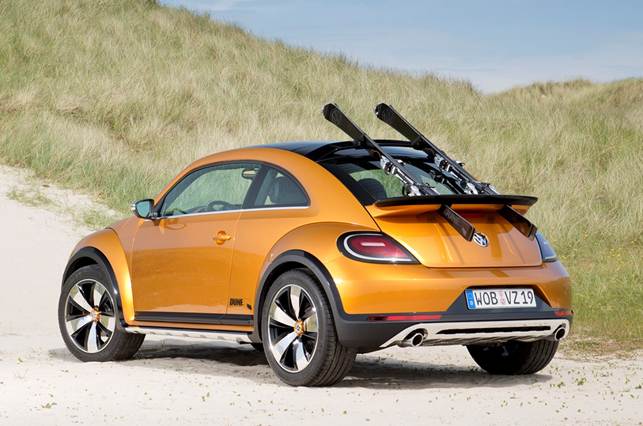Unlike the Fender Beetle and the GSR, the
Dune is not a limited-edition proposal. To secure the targeted 10% share of
approximately 100,000 Beetles per year, the Dune will be available with the
full choice of engines and options.
The police buggy brings back memories of
pupil-dilating lift-off oversteer, vehicle controls calibrated in the random
generator and an active safety concept largely dependent on one’s horoscope.
The engine’s dubbed voice is unmistakably air-cooled, the four-speed gearbox
baulks, the brake pedal relays the same indifferent sponginess as a Swiss ball,
the steering feels as reassuringly positive as a dowsing rod.

There's
an added grab handle in the facia ahead of the passenger seat
I’m inclined to attribute some of these
traits to the fact that our patrol car was not bred by one of the big-name
kit-car stables like Meyers, Apal, Albar, Karmann or EMPI. Instead, the
short-lived German firm GFK Design made the Rebell. This particular 1979 buggy
was a four-seater before the police station in St. Peter-Ording – a picturesque
North Sea resort – acquired it in 1999, converted it and painted it
green-over-white. The current blue-over-silver livery was applied at a later
stage. Since last year, a pair of mountain bikes do its work.
Comparing the vehicle dynamics of the Dune
and the buggy is a bit like pitting a Formula Vee racer against a milk float.
Although the Rebell does sit on a full-length chassis, it displays the
directional stability of a rattlesnake on the prowl. In response to the iffy
road holding and the tricky handling, the red-tape reps reduced the maximum
speed from the type-approved 75mph to a safer 50mph.

The
Beetle Dune receives a prominent roof spoiler and large rear wing
In stark contrast, the Dune is delightfully
easy to drive: it rides with the cushiness of a bigger and heavier car, and
with 207bhp it can accelerate in a brisk 7.3sec from 0-62mph. Although the
ground clearance has been increased by 50mm, the wider track (by 29mm) and
wider tyres (optional 255-series footwear) help to further enhance roadholding.
The six-speed DSG may not be world’s smoothest transmission, but it times gear
changes remarkably well in auto mode, and executes upshifts briskly.
The second-generation Beetle looks notably
more grown up and self-confident than the bubbly MkI effort, and the Dune is
arguably even prettier than the rest of the range. Why would we still hesitate
to put our name and money down for this fetching piece of street furniture?
Because it lacks essentials like four-wheel drive, adjustable dampers and any
kind of CO2-reducing add-ons. ‘We are well aware that there is room for
improvement,’ concedes Dzemal Sjenar, a senior VW engineer who is looking after
design exercises and concept cars. ‘The trouble is, all of the above items
require the more advanced modular MQB platform architecture which will be
introduced in the Puebla plant – the Mexican home of the Beetle – at a later
stage.’

Surfboards,
skis or snowboards can be mounted on the rear wing
Those in the know say that the next major
model changeover is due in 2018. The arrival of MQB promises greater
flexibility in terms of bodystyles, dimensional variation, drivetrain selection
and electronic componentry. With a bit of luck, Volkswagen may eventually
recreate the buggy, which would be good news for police-commissioner Struwe and
those who would love some modern yet affordable basic transportation with a
strong lifestyle twist.
While the front-drive Dune will likely do
well in image-conscious markets like the US and China, it is in essence an
exercise in brand cosmetics. Which is another way of saying that about four
more years of patience are required before a properly advanced dune conqueror will
arrive on VW dealer forecourts.